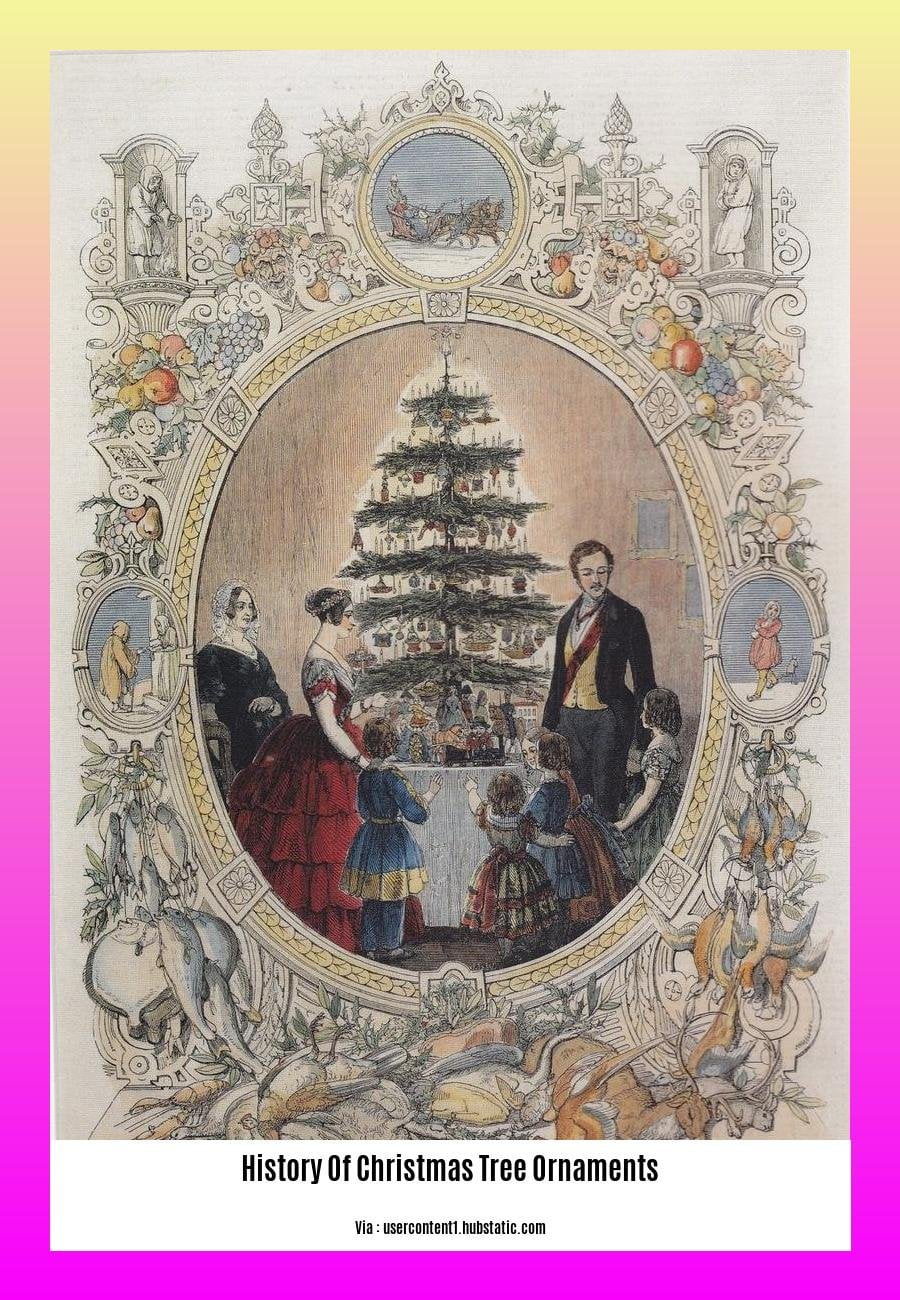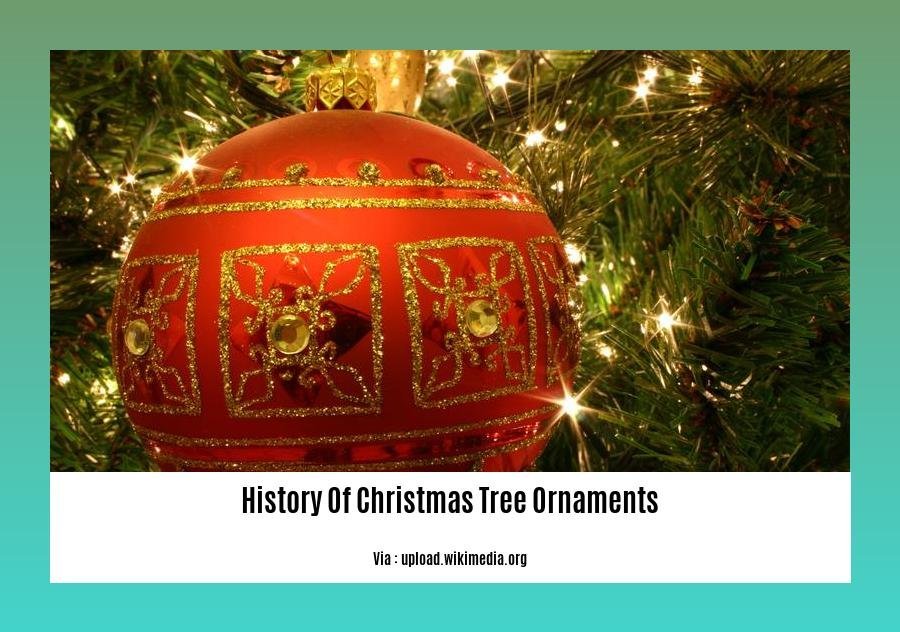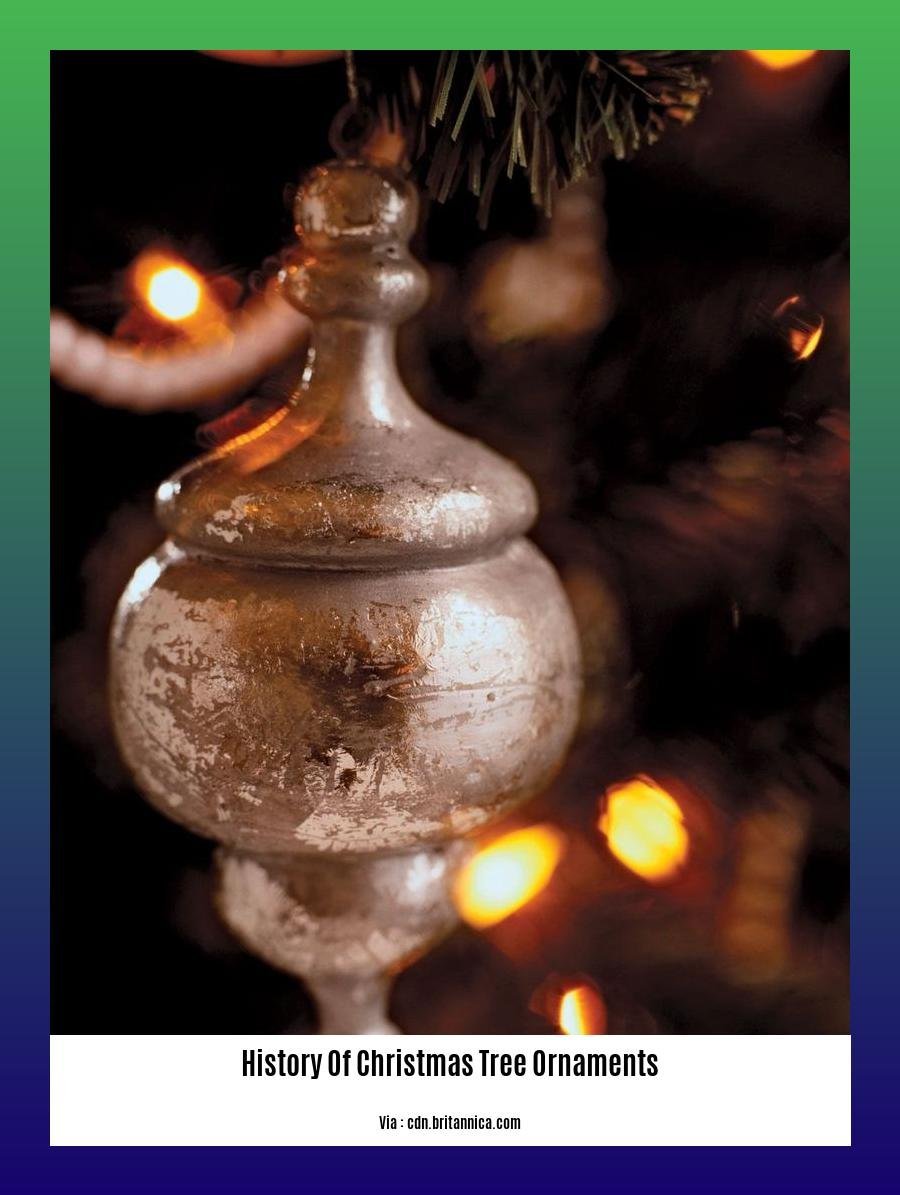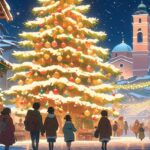Step into the enchanting world of Christmas tree ornaments, where history, culture, and tradition intertwine. In “Unveiling the Past: A Journey Through the History of Christmas Tree Ornaments,” we embark on a captivating exploration of the origins, evolution, and symbolism of these cherished decorations. Join us as we unravel forgotten stories, uncover hidden meanings, and discover how ornaments have shaped the Christmas season across time and cultures.
Key Takeaways:
- Christmas tree ornaments originated in Germany in the 1600s when people started decorating trees with fruits and nuts as a symbol of spring’s arrival.
- In 1605, a new era in Christmas tree decoration began when a fir tree was decorated with paper roses, nuts, fruits, and candles indoors.
- French tradition holds that Christmas tree lights were first used as decoration in the 18th century.
- In 1847, the invention of the man-made Christmas ornament revolutionized the way Christmas trees were adorned.
History of Christmas Tree Ornaments:

In the depths of winter, when the nights stretched long and the chill bit deep, our ancestors sought a beacon of hope, a symbol of enduring life. Thus, the Christmas tree, adorned with ornaments of exquisite beauty and profound meaning, was born. Join us on a magical journey as we explore the rich history of Christmas tree ornaments, tracing their evolution from humble beginnings to the cherished heirlooms we treasure today.
From Nature’s Bounty to Sparkling Treasures:
Long before tinsel and baubles graced our festive trees, people turned to nature’s bounty for adornment. Apples, nuts, and gingerbread—symbols of fertility and abundance—were strung upon branches, their earthy hues adding a touch of rustic charm.
In the 16th century, Germany, the birthplace of the Christmas tree, witnessed a transformation. Glassblowers, renowned for their intricate craftsmanship, began creating delicate glass ornaments, capturing the wonder of the season in shimmering spheres and whimsical figurines.
The Gleaming Glow of Candlelight:
As the 18th century dawned, a new element of enchantment was introduced—candlelight. The soft glow of flickering flames cast a warm and inviting ambiance, transforming the Christmas tree into a celestial spectacle.
The Dawn of Mass Production:
The invention of the man-made Christmas ornament in 1847 marked a pivotal moment. F.W. Woolworth, the retail pioneer, revolutionized the industry with his affordable ornaments, making them accessible to families from all walks of life.
A Tapestry of Cultural Traditions:
Over time, the Christmas tree evolved into a global symbol of festive cheer, with each culture weaving its unique threads into the tapestry of tradition. In Poland, intricately woven straw ornaments called “pajączky” symbolized good fortune. In Ukraine, delicate pysanky eggs, adorned with intricate designs, represented new life and rebirth.
Ornaments as Storytellers:
Each ornament that graces our trees holds a story, a cherished memory, or a heartfelt wish. They become tangible links to our past, connecting us with generations before us. They evoke nostalgia, warmth, and a sense of belonging, making the Christmas tree a repository of our collective heritage.
As we gather around our twinkling trees this holiday season, let us celebrate the enduring legacy of Christmas tree ornaments. May their beauty and symbolism remind us of the enduring spirit of hope, love, and joy that lies at the heart of this cherished tradition.
Unravel the fascinating history of Christmas tree lights and discover how they evolved from candles to the enchanting electric displays we adore today. Embark on a journey through time and learn the captivating story behind this beloved holiday tradition.
Explore the rich history of the Church of Christ and gain insights into its origins, beliefs, and practices. Delve into the fascinating narrative of this influential Christian denomination and uncover its impact on the religious landscape throughout history.
In-depth analysis of the various materials, techniques, and craftsmanship involved in the creation of these ornaments, highlighting the artistry and skill of their makers.
Christmas tree ornaments, with their intricate artistry and craftsmanship, have captivated hearts worldwide. The creation of these captivating pieces involves various materials, techniques, and methods, showcasing the remarkable skills and dedication of their makers.
Materials:
Ornaments showcase a breathtaking array of materials, each adding a unique character to the festive aura. From the radiant glow of glass to the warmth of wood and the delicate fragility of porcelain, the choice of material plays a pivotal role in shaping the ornament’s visual appeal and symbolic meaning.
Techniques:
The intricate techniques employed in ornament making are a testament to the artisans’ mastery. From the delicate art of glass blowing, where molten glass is transformed into shimmering spheres and intricate figurines, to the meticulous hand-painting that brings each ornament to life, every technique is a demonstration of skill and precision.
Craftsmanship:
The artistry and craftsmanship of ornament making are evident in the attention to detail and the pursuit of perfection. Each ornament is a labor of love, meticulously crafted by skilled hands. From the delicate shaping of glass to the intricate painting of intricate designs, every step reflects the artisan’s dedication to creating a masterpiece.
The ornaments’ journey from raw materials to cherished keepsakes embodies the essence of craftsmanship, where tradition, innovation, and creativity converge to create objects of enduring beauty.
Key Takeaways:
-
Diversity of Materials: Ornaments utilize a diverse range of materials, including glass, wood, porcelain, and fabric, each imparting unique visual and symbolic qualities.
-
Intricate Techniques: Ornament making involves a range of techniques, such as glass blowing, hand-painting, and sculpting, showcasing the artisans’ mastery and precision.
-
Craftsmanship and Dedication: Each ornament is a testament to the artisan’s skill, dedication, and pursuit of perfection, resulting in exceptional works of art.
-
Cultural Heritage: Ornaments often reflect cultural influences, embodying traditions, beliefs, and stories from around the world.
-
Emotional Connection: Ornaments hold sentimental value, evoking cherished memories and creating a sense of connection to family, heritage, and the spirit of the holiday season.
UNESCO – Intangible Heritage Home
The Importance of Craftsmanship in the Digital Age
Presentation of personal anecdotes and stories from individuals whose lives have been touched by the tradition of Christmas tree ornaments, emphasizing their emotional and sentimental value.

In homes across the world, the Christmas tree stands as a beacon of festive cheer, its branches laden with ornaments. These adornments aren’t just embellishments; they’re emblems of tradition, emblems of cherished memories, and emblems of lives enriched by the magic of the season.
-
My grandmother, Anna, was a young girl in Poland when she first encountered the custom of ornamenting Christmas trees. The family was poor, but each year, Anna’s mother would painstakingly craft straw ornaments, intricate designs that represented good fortune. As Anna grew older, she carried on this tradition, passing it down to her own children and grandchildren.
-
For Sarah, a Christmas ornament wasn’t just a decoration; it was a connection to her late husband, John. Among their cherished ornaments was a delicate glass dove. It symbolized their love, their shared dreams, and their enduring bond. Every year, Sarah would hang the dove on the tree, cherishing the memories it evoked.
-
For generations, the Garcia family has celebrated Christmas with a unique tradition. Each member crafts a personalized ornament, reflecting their passions or milestones. These ornaments, a vibrant collection of painted angels, whimsical snowmen, and sparkling stars, serve as a visual autobiography of the family’s rich history.
These stories, and countless others like them, illustrate how Christmas tree ornaments transcend mere decoration; they become vessels of emotion, memory, and tradition. They remind us that the Christmas tree is more than a festive symbol; it’s a repository of our collective stories.
Key Takeaways:
- Ornaments are more than just decorations; they are symbols of tradition and cherished memories.
- The tradition of ornamenting Christmas trees has been passed down through generations, connecting families to their past.
- Ornaments can represent special moments, people, or places, adding a personal touch to the Christmas tree.
- Creating and sharing ornaments is a way to express creativity and connect with loved ones.
- Ornaments can be used to celebrate different cultures and traditions, adding a touch of diversity to the Christmas tree.
[URL Sources]:
- The History and Symbolism of Christmas Tree Ornaments
- The Meaning of Christmas Tree Ornaments
Discussion of the role of Christmas tree ornaments in shaping the festive atmosphere and holiday spirit during the Christmas season.
Christmas tree ornaments, with their gleaming glass, vibrant colors, and intricate designs, are not mere decorations; they hold a profound significance in shaping the festive atmosphere and holiday spirit of the Christmas season. From their humble beginnings in the depths of winter forests to their transformation into modern-day symbols of joy, ornaments have woven their way into our cultural tapestry, adding an extra layer of magic to the most wonderful time of the year.
Harkening back to the 16th century in Germany, the tradition of decorating Christmas trees took root. Early ornaments were crafted from fruits, nuts, and paper roses, each representing a symbol of abundance, fertility, and good fortune. These simple adornments reflected the deep connection between nature and the holiday, a reminder of life amidst the harsh winter.
As time went on, the art of ornament making evolved. In the 1800s, glass blowers in the town of Lauscha, Germany, began crafting exquisite glass ball ornaments, known as baubles. These delicate glass wonders, with their shimmering reflections and vibrant hues, quickly gained popularity and transformed the Christmas tree into a dazzling spectacle of light and color.
The symbolism associated with Christmas tree ornaments runs deep and diverse. The Christmas star, often perched atop the tree, represents the Star of Bethlehem that guided the Wise Men to the birthplace of Jesus. Angels, with their wings spread wide, symbolize the heavenly messengers who heralded the birth of the Christ child. Candy canes, with their distinctive red-and-white stripes, originated in Germany and were initially used to help children sit still during long church services.
Beyond their religious symbolism, Christmas tree ornaments have become a canvas for expressing personal memories, traditions, and cultural heritage. Families often pass down ornaments from generation to generation, each one holding a sentimental value that transcends its material form. These cherished mementos evoke a sense of nostalgia and warmth, connecting us to our past and strengthening the bonds of family and community.
Ornaments also reflect the diversity of cultures around the world. In Poland, for example, intricate straw ornaments known as pajączky are crafted to bring good fortune, while in Ukraine, pysanky eggs, elaborately decorated with traditional Ukrainian folk designs, symbolize new life and rebirth.
Today, the tradition of decorating Christmas trees with ornaments has become a global phenomenon, transcending cultural and religious boundaries. The festive atmosphere and holiday spirit that surrounds Christmas trees would be incomplete without these enchanting adornments. Each ornament, with its unique story and symbolism, plays a vital role in creating the magical ambiance that makes the Christmas season so special. As we gather around the brightly lit tree, surrounded by cherished ornaments, we are reminded of the joy, love, and hope that lies at the heart of this beloved holiday tradition.
Key Takeaways:
-
Christmas tree ornaments originated in Germany in the 16th century, using fruits, nuts, and paper roses.
-
Glass ball ornaments, or baubles, were introduced in the 1800s and became immensely popular due to their beauty and craftsmanship.
-
Ornaments hold religious symbolism, such as the Christmas star representing the Star of Bethlehem and angels representing heavenly messengers.
-
Candy canes, with their distinctive red-and-white stripes, were originally used to help children sit still during church services.
-
Ornaments have evolved into a canvas for expressing personal memories, traditions, and cultural heritage, becoming cherished mementos passed down through generations.
-
Different cultures have unique ornaments, such as Polish straw ornaments (pajączky) for good fortune and Ukrainian pysanky eggs for new life.
-
Christmas tree ornaments create a festive atmosphere and embody the joy, love, and hope associated with the holiday season.
Sources:
The History of Christmas Ornaments
The Real History of Christmas Ornaments
FAQ
Q1: When did the tradition of decorating Christmas trees originate?
A1: The tradition of decorating Christmas trees originated in Germany in the 16th century, where people added fruits, nuts, and paper roses to trees once the leaves had fallen off to symbolize the promise of spring to come.
Q2: What were the first Christmas tree ornaments made of?
A2: The first Christmas tree ornaments were made from fruits, nuts, and paper roses. In the 1800s, Hans Greiner started making glass ball ornaments (baubles), which became increasingly popular.
Q3: What do traditional German Christmas ornaments symbolize?
A3: Traditional German Christmas ornaments, known as Christbaumschmuck, often feature symbols such as the Christmas star, which represents the Star of Bethlehem, and angels, which represent the angel that appeared to Mary and Joseph to announce the birth of Jesus.
Q4: What is the history of the Christmas star ornament?
A4: The Christmas star ornament symbolizes the Star of Bethlehem, which guided the Wise Men to Jesus’ birthplace. It is often placed at the top of the Christmas tree to represent the guiding light that led the Wise Men to Jesus.
Q5: What is the history of the candy cane ornament?
A5: Candy canes originated in Germany around 1670 and were originally used to help children sit still during Christmas services. The shape of the candy cane is said to represent the shepherd’s crook, and the red and white stripes are said to represent the blood of Christ and the purity of his love.
- Unveiling Bernhard Caesar Einstein’s Scientific Achievements: A Legacy in Engineering - July 15, 2025
- Uncover who is Jerry McSorley: CEO, Family Man, Business Success Story - July 15, 2025
- Discover Bernhard Caesar Einstein’s Scientific Contributions: Unveiling a Legacy Beyond Einstein - July 15, 2025















